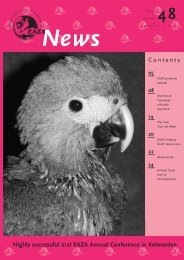EAZA News 58-9 - European Association of Zoos and Aquaria
EAZA News 58-9 - European Association of Zoos and Aquaria
EAZA News 58-9 - European Association of Zoos and Aquaria
Create successful ePaper yourself
Turn your PDF publications into a flip-book with our unique Google optimized e-Paper software.
Martin Wehrle, Goldau Zoo, Switzerl<strong>and</strong><br />
Bearded vulture EEP<br />
For twenty years now, bearded vultures have however been reintroduced<br />
into the Alps via a project supported by almost thirty zoological institutions.<br />
The Bearded vulture EEP, one <strong>of</strong> the first EEPs, was established in<br />
1986, <strong>and</strong> mainly focuses on the conservation <strong>of</strong> bearded vultures in the<br />
wild. For a long time breeding bearded vultures in captivity seemed almost<br />
impossible. One <strong>of</strong> the main problems was the difficulty in distinguishing<br />
males from females by external features, which hampered the formation<br />
<strong>of</strong> pairs. New techniques have made sex determination much easier. In<br />
January 2006, the Bearded vulture EEP counted 66.60.1 birds. That same<br />
year 19 eggs hatched, <strong>of</strong> which 16 chicks were raised successfully by their<br />
parents or foster parents. Ten chicks have been released in Austria, Italy<br />
<strong>and</strong> for the first time in Spain (Sierra de Cazorla). Since the establishment<br />
<strong>of</strong> the Bearded vulture EEP, 144 juveniles have been released into the wild.<br />
Successful rearing at Goldau Zoo<br />
Goldau Zoo in Switzerl<strong>and</strong> is also involved in the bearded vulture reintroduction<br />
project. Several zoos keep this species, but each year, only a few<br />
captive pairs breed. Goldau Zoo has been trying to breed with the species<br />
since 1995. The zoo built two additional breeding aviaries in 1998, so<br />
a total <strong>of</strong> three pairs <strong>of</strong> bearded vultures could be kept. The first egg<br />
hatched in 2000. The zoo opened a new exhibit in 2005, informing the<br />
visitors about the bearded vulture, its biology, its extinction <strong>and</strong> the<br />
reintroduction project. Last year was very successful; due to the great<br />
devotion <strong>of</strong> the zoo staff, three bearded vultures were successfully raised.<br />
The staff had to deal with several problems during the rearing period <strong>and</strong><br />
one <strong>of</strong> the <strong>of</strong>fspring was transported to the Vienna Breeding Unit to be<br />
reared by foster parents. Two <strong>of</strong> these three bearded vultures have now<br />
been released (one in Martelltal <strong>and</strong> one in Hohe Tauern) <strong>and</strong> the third<br />
one went to another breeding centre.<br />
Late February 2007, another two chicks hatched. One <strong>of</strong> the chicks died<br />
due to a goitre infection. The other chick is developing well <strong>and</strong> will be<br />
reintroduced in the Swiss National Park in June.<br />
conservation<br />
Reintroduction <strong>of</strong> the bearded vulture<br />
photo michael knollseisen<br />
For a long time the bearded vulture (Gypaetus barbatus) was hunted fiercely, due to the superstition that,<br />
besides slaughtering lambs in its wild dives, this gigantic bird would not even shy from stealing children....<br />
This lack <strong>of</strong> knowledge led to the noticeable disappearance <strong>of</strong> the bearded vultures in the Alps.<br />
Bearded vultures on the move<br />
The success <strong>of</strong> this project shows the importance <strong>of</strong> zoo cooperation <strong>and</strong><br />
support in conservation <strong>of</strong> <strong>European</strong> flagship species. As many as eight<br />
young vultures could be released at four sites in the Alps during successful<br />
project years. Since 1997, 33 <strong>of</strong>fspring have hatched in the wild <strong>and</strong> the once<br />
extinct vulture has a new <strong>and</strong> growing natural population. The project<br />
‘Bearded vulture on the move’ began in 2004. Released single young bearded<br />
vultures are marked with satellite transmitters, allowing a broad public to<br />
continuously follow each single bird on the internet. The marked birds are<br />
located with the help <strong>of</strong> satellites which circle the earth in the north-south<br />
axis at a height <strong>of</strong> 850 km. This interesting information helps to fascinate<br />
people about the bearded vulture <strong>and</strong> its alpine habitat. Futhermore, the<br />
technology provides basic data to study spatial behaviour.<br />
photo goldau zoo<br />
Testing transmitters<br />
Before the project began, the fixation <strong>of</strong> the satellite transmitters was tested<br />
on bearded vultures <strong>of</strong> Goldau Zoo. Two systems proved to be successful;<br />
the affixation <strong>of</strong> a transmitter onto a tail feather <strong>and</strong> the affixation with an<br />
elastic b<strong>and</strong> which lies around the hips (like a climber’s belt). Consequently,<br />
two vultures were released <strong>and</strong> could be monitored in 2005 <strong>and</strong> 2006.<br />
Currently, the use <strong>of</strong> satellite transmitters with GPS modules is being<br />
evaluated. This would enable more accurate location data in the future.<br />
The position <strong>of</strong> the vultures can still be observed via the internet through<br />
www.bartgeier.ch/unterwegs •<br />
eaza news <strong>58</strong><br />
2007<br />
25

















